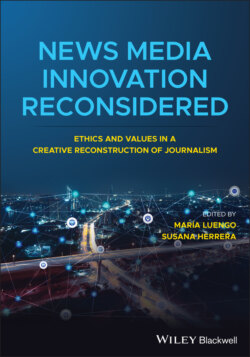Читать книгу News Media Innovation Reconsidered - Группа авторов - Страница 31
Features of the Continuum
ОглавлениеThe first feature is this: Where exactly a form of journalism should be placed on the continuum to be debated. For example, should I have placed investigative journalism before or after advocacy journalism? Why is civic journalism placed last on the continuum? It should not surprise us that precision in categorizing is difficult. Journalism is too complex an area to be divided neatly into kinds of journalism. Differences are matters of degree, and different kinds of journalism combine values in various ways. The continuum is a map of a complex terrain. The aim of the continuum is not precision in placement but to show how kinds of journalism can be roughly grouped into three categories of moral ideology.
Second, the differences between the kinds of journalism are matters of degree. Generally speaking, as one moves from left to right, we move from a journalism that is more invested in acting as a public spectator and sticking close to the “shoreline” of available facts, than in venturing out into the choppy waters of political opinion and advocacy. There is a greater degree of strict factual accuracy and pre-publication verification. As we approach the right-handed pole, there are greater amounts of hypothesizing, speculating, and theorizing. Journalists are also more active in the public sphere.
Third, the continuum helps to highlight misconceptions. For example, the continuum shows that all three forms of journalism have goals and values. Disengaged journalism, such as neutral reporting, has its own goals. The ethical point of adopting the disengaged model is to provide the public with a relativity unbiased stream of factual information. This stream of information is important because it helps to create an informed democracy. However, disengaged journalism has not always stressed that it too has goals and is engaged in society. In fact, the ideology has often implied that neutral reporters are not engaged at all. In this view, to be “engaged” was to be a political partisan or a social activist. Journalists are not, or should not be, engaged.
Fourth and finally, the continuum reminds us that certain kinds of journalism may combine norms from the three categories. For example, investigative journalists combine disengaged journalism’s stress on facts with engaged journalism’s stress on stories that prompt reform.
